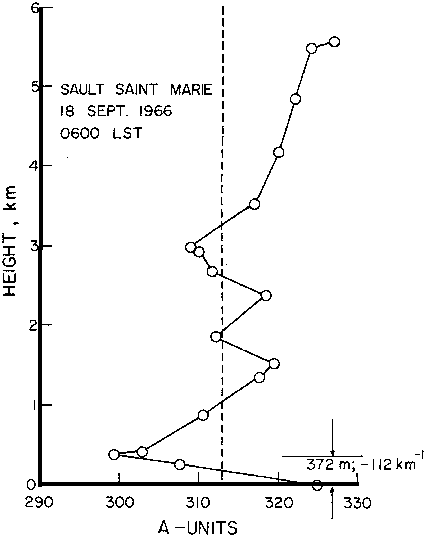
1323-B. Base aérienne de Sault Saint Marie (Michigan), 18 septembre 1966, 0100
LST. Météo : temps clair et calme. Il existe une brève fiche Blue Book sur cet incident. 2 sergents du 753ème
Escadron Radar virent une lumière brillante, de forme ellliptique et aux teintes apparemment multicolores et
désaturées, which appeared low over the treetops to the SE and moved in a straight line toward the west, disappearing
instantaneously
in the WSW. Duration of this sighting was 2-5 sec. The report states that the object was also
tracked by a long-range AN/FPS-90 heightfinder with azimuth, range, and altitude available on request
. Since
this information is not included in the folder, no firm conclusion may be reached as to the probable cause of the
radar sighting or even as to whether or not the radar and visual objects were correlated.
The general visual appearance, brightness range, motion and mode of disappearance are all compatible with the hypothesis that the object was a large meteor. Some large meteors display even more unusual appearance than this report. If it was a meteor, the radar may have actually tracked it; radar tracks of large meteors are not unknown. Of course, the radar track may have been spurious, or may have indicated that the object was unnatural. The tracking data would be required to settle the point.
The radio refractivity profile for , shown if Fig. 3 indicates that an intense super-refractive layer existed within the first 372 m (1220 pieds) above the surface. This profile is conducive to the formation of AP echoes on ground-based radar, so there is some possibility that the observed radar data in this UFO incident may have been spurious. This case would seem to merit further investigation.
1206-N. Edmonton (Alberta), 6 avril 1967, à . Météo : temps très clair
, froid,
température d'environ 35 °F, peu ou pas de vent de surface, étoiles brillantes
, pas de Lune visible. Observers
state that a bright object appeared in the NNW low on the horizon, moving fast, appeared to hover, and then
disappeared. The night before, a whitish object like a normal star only much larger
had appeared in the same
place (NNW). A Pacific Western Airlines pilot independently reported chasing
a UFO whose position was relayed
to him by GCA radar from Edmonton International Airport. This UFO appeared to move somewhat erratically, was seen only
briefly by the pilot as a reddish-orange lighted effect
, and did not travel the same course as the visual
object described above.
The general atmospheric conditions prevailing during this sighting were conducive to AP. The description of the GCA
radar track is suggestive of AP (quasi-stationary target appearing to jump
in position), and the description of
the UFO of 5 April is suggestive of the diffracted image of a star seen through a sharp temperature inversion. In the
absence of detailed meteorological data, the most probable conclusion seems to be that the primary sighting was a
meteor and that no genuine UFO case exists here. However, this case also might merit a more intensive investigation.
1207-B. Paris (Texas), 7 mars 1967, . Météo : temps clair, visibilité 15 miles. Il s'agit
d'un signalement non confirmé par un observateur unique qui n'a même pas pu être joint pour vérification du
signalement par des membres de l'équipe de ce projet. Il a déclaré avoir vu 2 lumières qui firent un virage à 90 ° à grande vitesse,
semblèrent se séparer et revinrent à nouveau ensemble puis partirent droit vers le haut. La vitesse varia de rapide à
lent à rapide à nouveau, dépassant la vitesse d'appareils connus
. La dernière phrase est l'interprétation du
témoin. Il déclara que le radar de la base aérienne de Paris avait repéré cet ovni, mais toutes les installations
militaires de la région contestèrent toute trace d'ovni cette nuit-là. Il semble probable que l'observation visuelle
était soit un appareil, dont le son ne fut pas entendu par
le témoin pour une raison ou une autre, ou une paire de météores sur des trajectoires proches,
pratiquement parallèles. The quick dimming of a meteor burning out may be interpreted as a 90° turn with sudden
acceleration away from the observer of a nearly-constant light source, which then seems to disappear in the distance.